Rubber feet stop lab equipment shaking by converting vibrational energy into heat through their viscoelastic properties. They combine elasticity (returning to original shape) with viscosity (energy dissipation), creating an effective damping system. With the right durometer rating (30-50 Shore A is ideal), rubber feet can absorb up to 96% of vibrations, protecting sensitive instruments and ensuring measurement accuracy. The right material choice and proper installation can dramatically improve your equipment’s stability and precision.
Numeric List of 12 Second-Level Headings
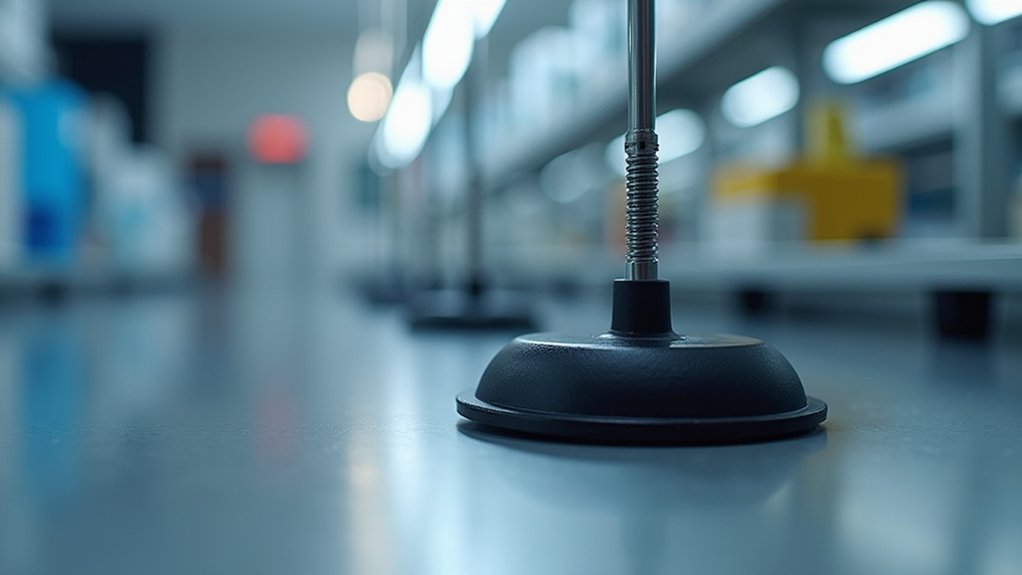
Twelve vital aspects of rubber feet demand attention when selecting them for your lab equipment. When designing your vibration damping solution, consider these essential areas:
- Durometer Hardness Selection
- Material Composition Analysis
- Installation Requirements
- Low-Frequency Vibration Control
- Anti-Vibration Performance Testing
- Maintenance Schedules
- Weight Distribution Efficiency
- Surface Contact Area
- Environmental Resistance Properties
- Replacement Indicators
- Cost-Benefit Analysis
- Compatibility with Sensitive Instruments
Each heading represents a critical factor in maximizing vibration isolation. For instance, proper installation (#3) directly impacts dampening effectiveness, while regular inspection (#7) prevents degradation of anti-vibration properties.
Meticulous attention to rubber feet selection criteria ensures optimal equipment stability and extends the lifespan of sensitive laboratory instruments.
You’ll need to match the feet’s softness (#1) to your specific equipment weight to achieve ideal results, particularly for instruments affected by low-frequency oscillations around 33 Hz (#4).
The Science Behind Viscoelastic Materials in Laboratory Settings
While traditional materials remain static when stressed, viscoelastic substances like rubber exhibit unique dual properties that make them ideal for laboratory vibration control. When you place rubber feet under your equipment, you’re employing sophisticated vibration dampening technology that converts harmful kinetic energy into heat through internal friction.
| Property | Function | Benefit |
|---|---|---|
| Elasticity | Returns to original shape | Maintains stability |
| Viscosity | Dissipates energy as heat | Reduces vibration amplitude |
| Variable deformation | Adapts to different forces | Handles various vibration types |
| Durometer hardness | Balances softness and support | Optimizes dampening effect |
| Frequency response | Counteracts specific vibrations | Protects sensitive instruments |
These viscoelastic materials can reduce vibrations by up to 96%, dramatically improving the accuracy of your sensitive instruments like IR spectrophotometers and preventing measurement errors.
How Rubber’s Damping Properties Absorb Vibrational Energy
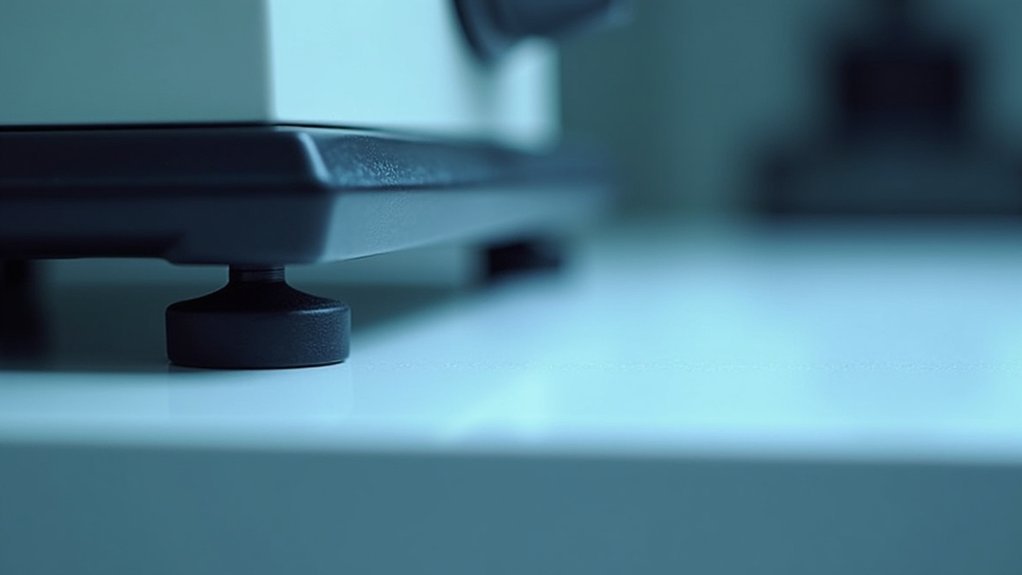
When vibrational energy strikes rubber feet beneath your lab equipment, a remarkable energy conversion process begins. The viscoelastic nature of rubber acts as a natural vibration isolation system, transforming kinetic energy into heat through molecular friction.
The damping effectiveness depends on several factors:
- The rubber’s Durometer rating (softness similar to a pink eraser works best for lighter equipment)
- The material’s ability to absorb across multiple frequency ranges
- The physical deformation capacity that dissipates energy
- The conversion efficiency from mechanical to thermal energy
You’ll see up to 96% reduction in transmitted vibrations when using appropriate rubber feet.
This impressive dampening capability protects your sensitive instruments from external disturbances and prevents measurement errors that could compromise experimental results.
The Impact of Equipment Vibration on Research Precision
When your lab equipment vibrates, you’ll notice measurement drift issues that compound over time, rendering your meticulously collected data unreliable.
These unwanted movements can skew calibration results, causing instruments like the IR spectrophotometer—with its vulnerability to vibrations of up to 30.5 microns horizontally—to produce inconsistent readings that compromise research integrity.
The resulting signal-to-noise degradation makes it increasingly difficult to distinguish relevant data from background interference, potentially invalidating years of research and threatening patient care outcomes that depend on precise measurements.
Measurement Drift Issues
Nearly all precision laboratory research suffers when equipment vibrations introduce measurement drift. Your sensitive instruments, like IR spectrophotometers, can detect vibrations at frequencies around 33 Hz, causing significant data variability and compromising research outcomes.
When you’re conducting experiments requiring high precision, measurement drift can manifest as:
- Inconsistent readings between trials
- Baseline shifts during critical measurements
- Data variability exceeding acceptable margins of error
- False positives or negatives in analytical results
Without proper vibration control, even routine movements in your lab contribute to this problem. Instruments experience vertical vibrations of up to 15.4 microns and horizontal movements reaching 30.5 microns—enough to invalidate sensitive measurements.
This measurement drift doesn’t just affect individual readings; it undermines the entire reliability of your experimental data and research conclusions.
Skewed Calibration Results
Because your calibration procedures demand absolute precision, vibration-induced errors represent one of the most insidious threats to research validity.
When your lab instruments experience vibrations—with amplitudes potentially reaching 15.4 microns vertically and 30.5 microns horizontally—your calibration results become skewed, undermining measurement accuracy.
These inaccuracies aren’t just minor inconveniences; they can invalidate years of meticulous research and compromise high-stakes, time-sensitive lab tests. The consequences directly impact patient care and data integrity.
That’s why installing vibration pads is essential for your equipment stability.
Effective vibration damping solutions, like rubber feet, can reduce transmitted vibrations by approximately 96%.
This significant improvement guarantees your calibration procedures remain precise and your research outcomes reliable, protecting your investment in both equipment and scientific discovery.
Signal-to-Noise Degradation
Beyond calibration errors, vibration creates another fundamental problem: signal-to-noise degradation. When your IR spectrophotometer experiences 33 Hz vibrations with amplitudes of 15.4 microns vertically and 30.5 microns horizontally, you’re not seeing true readings—you’re seeing interference patterns that mask actual results.
This degradation directly impacts your research precision in several critical ways:
- Compromises time-sensitive experiments that can’t be repeated
- Wastes costly reagents and materials on invalid test results
- Jeopardizes years of research efforts due to unreliable data
- May affect patient care when diagnostic equipment is involved
Effective vibration isolators, like neoprene feet designed to absorb over 50% of vibrations, can reduce frequencies to 1-2 Hz.
With a potential 96% vibration reduction, your signal-to-noise ratio dramatically improves, ensuring your instruments capture data, not disturbance.
Comparing Different Durometer Ratings for Optimal Performance
When selecting rubber feet for laboratory equipment, understanding durometer ratings is essential for achieving ideal vibration control. The Shore A scale indicates rubber hardness—lower numbers mean softer material with better vibration damping capabilities.
For lab instruments, durometer ratings between 30-50 Shore A offer the best performance. These softer feet, comparable to pink erasers, conform to uneven surfaces and maximize contact area, markedly improving isolation from unwanted vibrations.
Harder rubber (above 70 Shore A) won’t absorb vibrations effectively, potentially compromising the precision of sensitive instruments.
Consider your equipment’s weight when choosing—lighter devices benefit from softer feet, while heavier equipment might require somewhat firmer options to balance stability with vibration control. The right durometer rating guarantees your equipment stays steady during critical operations.
Microscope Stability Requirements for High-Magnification Photography
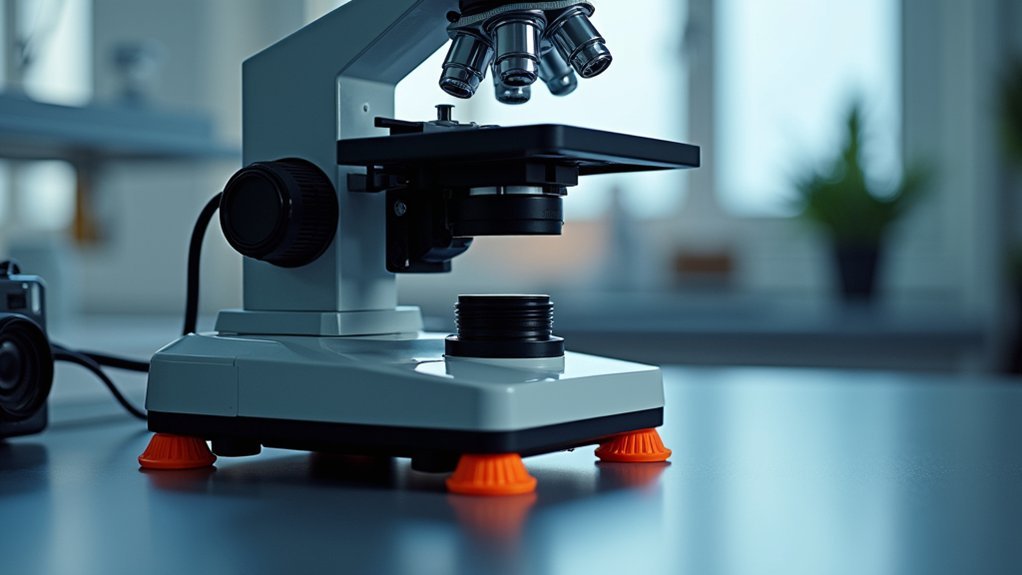
High-magnification microscope photography demands exceptional stability that ordinary equipment setups often can’t provide.
Even tiny vibrations exceeding 1-2 Hz will blur your images and compromise precision. To achieve the clarity needed for detailed microscopy work, you’ll need to reduce the amount of environmental vibration reaching your equipment.
Effective stability solutions include:
- Installing rubber feet or a vibration pad to absorb disruptive movements
- Placing your microscope on high-mass surfaces like concrete or heavy lab tables
- Ensuring complete isolation from foot traffic and nearby equipment
- Recalibrating your equipment after implementing vibration-dampening measures
When properly stabilized, your microscope can maintain the focus integrity required for capturing crisp, detailed images at high magnifications.
This allows you to document specimens with scientific accuracy.
Strategic Placement of Rubber Feet for Maximum Vibration Reduction
When placing rubber feet on your lab equipment, you’ll achieve maximum vibration reduction by positioning them at the corners where the weight distribution creates ideal stability.
You should consider your equipment’s mass distribution, ensuring heavier components are properly supported by strategically located feet that can absorb the concentrated forces.
For asymmetrical instruments, you may need additional feet placed beneath areas of greater mass to prevent wobbling and effectively isolate the equipment from environmental vibrations.
Optimal Corners Placement
The four corners of laboratory equipment provide the most strategic positions for rubber feet installation. This placement creates a balanced foundation that can reduce vibrations by up to 96% while maximizing stability.
Your damping pads work most effectively at corners because they’re closer to the equipment’s center of mass, efficiently funneling disruptive energy away from sensitive components.
For ideal vibration reduction, consider:
- Using softer rubber materials that conform better to surfaces
- Ensuring all four feet make complete contact with the work surface
- Distributing weight evenly across all corners
- Positioning feet directly under the heaviest components when possible
This strategic corner placement minimizes misalignment risks and protects delicate parts from wear, ultimately improving measurement accuracy and extending your equipment’s operational life.
Mass Distribution Considerations
Proper mass distribution greatly impacts how effectively rubber feet reduce vibrations in laboratory equipment. When setting up your devices, you’ll want to position heavier components lower in the equipment to create a lower center of mass. This simple adjustment enhances stability and minimizes shaking effects.
For ideal vibration reduction, place rubber feet strategically in alignment with your equipment’s weight distribution. This guarantees even support across the base and prevents tilting that could generate unwanted vibrations.
Using multiple feet helps distribute the load evenly, improving absorption and eliminating stress points that cause instability.
For maximum effectiveness, position your equipment on solid, high-mass surfaces. Additionally, adjusting rubber feet to complement your equipment’s natural frequency can enhance vibration isolation, ensuring the feet absorb rather than amplify vibrations.
Material Composition: Neoprene vs. Sorbothane vs. Natural Rubber
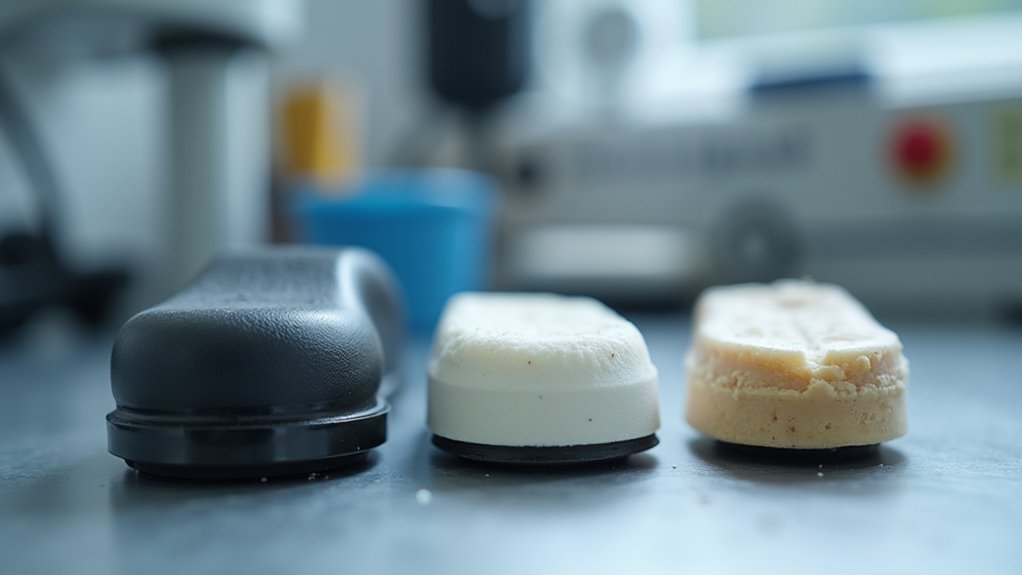
Selecting the right rubber material for laboratory equipment feet involves understanding key differences in composition and performance characteristics. Sorbothane stands out with its remarkable vibration dampening properties, absorbing up to 96% of vibrations—critical for sensitive instruments where stability is paramount.
When choosing between materials, consider these factors:
- Durometer rating (hardness) affects absorption capabilities—softer materials generally work better for lighter equipment.
- Environmental exposure—neoprene offers excellent resistance to chemicals and environmental factors.
- Longevity—natural rubber may degrade when exposed to certain lab chemicals.
- Application sensitivity—Sorbothane’s viscoelastic properties make it ideal for precision instruments.
Your choice ultimately depends on balancing cost against the level of vibration isolation your specific equipment requires. For highly sensitive instruments, you’ll find Sorbothane’s superior cushioning properties worth the investment.
Environmental Factors Affecting Rubber Foot Performance
Temperature variations in your lab can cause rubber feet to harden or lose elasticity, diminishing their vibration-dampening effectiveness over time.
You’ll notice decreased performance in high-humidity environments where moisture degrades rubber compounds and potentially distorts their shape.
Chemical exposure presents another significant concern, as solvents and corrosive substances commonly found in laboratory settings will accelerate deterioration of rubber materials, compromising both structural integrity and vibration isolation properties.
Temperature Range Effects
Although often overlooked, the temperature of your laboratory environment greatly impacts the performance of rubber feet on equipment. Rubber’s viscoelastic properties function efficiently within -20°C to 70°C (-4°F to 158°F). Outside this temperature range, vibration absorption capabilities diminish considerably.
When monitoring your lab conditions, be aware that:
- High temperatures cause rubber to soften, reducing structural integrity
- Cold environments make rubber brittle, compromising shock absorption
- UV light and ozone exposure accelerate deterioration when combined with temperature fluctuations
- Temperature changes alter rubber’s ability to dissipate vibrational energy
You’ll need to regularly assess your laboratory’s temperature conditions to maintain rubber feet effectiveness.
This proactive approach guarantees your equipment remains stable and properly isolated from unwanted vibrations throughout experimental procedures, extending the functional lifespan of both the feet and your instruments.
Humidity Impact Assessment
Beyond temperature considerations, humidity stands as another critical environmental factor affecting rubber feet performance in laboratory settings.
When your lab experiences high humidity levels, the rubber material in vibration-dampening feet can absorb moisture, causing them to swell and lose elasticity. This moisture absorption directly compromises their ability to isolate specific vibration frequencies effectively.
You’ll notice this degradation happens progressively – as humidity penetrates the rubber compounds, their damping properties alter, reducing effectiveness over time.
For your sensitive equipment, this means diminished protection against unwanted vibrations. Maintaining controlled humidity levels in your laboratory isn’t just about comfort; it’s essential for preserving the functional properties of rubber feet.
Without proper humidity management, you’ll face more frequent replacements of these components to maintain ideal vibration isolation performance.
Chemical Exposure Concerns
While humidity challenges your equipment’s rubber feet over time, chemical exposure presents a more immediate and severe threat in laboratory environments.
When rubber materials contact harsh chemicals, they can rapidly degrade, compromising vibration dampening performance and potentially destabilizing your sensitive equipment.
The effects of chemical exposure on rubber feet include:
- Swelling or hardening that reduces elasticity and shock absorption
- Structural breakdown leading to diminished vibration dampening capacity
- Accelerated deterioration when combined with temperature fluctuations
- Material breakdown causing rubber to flake, crack, or disintegrate
Your lab’s corrosive substances can chemically attack rubber compounds, necessitating more frequent replacements.
Implementing regular inspections for signs of degradation will help maintain effective vibration isolation in your sensitive lab setting, protecting both equipment function and measurement accuracy.
Combining Mass and Isolation Techniques for Enhanced Stability
When seeking maximum stability for sensitive lab equipment, combining mass and isolation techniques offers a synergistic approach that addresses vibration from multiple angles.
You’ll achieve superior results by placing equipment on heavy concrete pavers and using specialized isolation pads like Sorbothane to absorb vibrations without stressing components.
Adding mass to your equipment frame creates inherent resistance to movement—heavier setups simply don’t vibrate as easily as lighter ones.
For thorough protection, anchor solid racks to your building’s structure, eliminating unstable surfaces that could transmit unwanted motion.
Remember that after implementing these mass and isolation strategies, you’ll likely need to recalibrate your instruments.
This final step guarantees your newly stabilized equipment maintains the precision and accuracy your lab work demands.
Customizing Rubber Solutions for Specific Laboratory Equipment
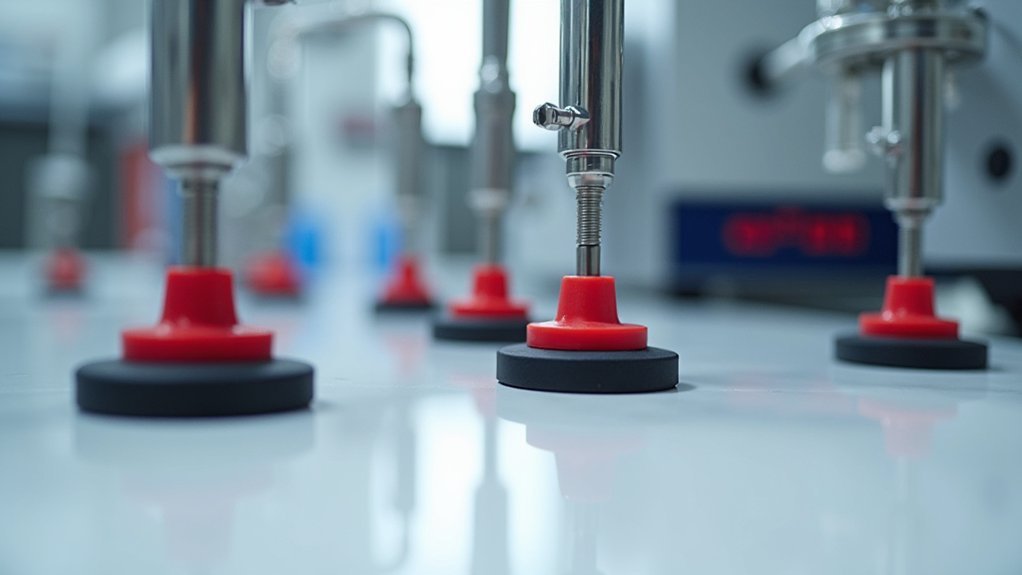
Precision instruments demand tailored vibration control solutions that address their unique requirements.
You’ll find that custom rubber solutions like Sorbothane dampening pads can reduce vibrations to levels as low as 1-2 Hz, protecting your sensitive lab equipment from accuracy issues.
When selecting custom rubber solutions, consider:
- Durometer rating (softness) appropriate for your instrument’s weight
- Dimensions that match your equipment’s footprint
- Weight distribution requirements for ideal stability
- Non-slip properties to prevent movement during operation
Practical Implementation in Microscope Photography Applications
Since microscope photography demands exceptional stability, implementing proper rubber feet solutions can dramatically improve image quality and research outcomes.
When you’re capturing high-resolution microscope images, even minor vibrations transmitted from the environment can blur your results and compromise data integrity.
To effectively absorb shock, select rubber feet with appropriate Durometer ratings that match your microscope’s weight and sensitivity requirements.
Install them strategically at the base corners, ensuring even weight distribution. You’ll notice immediate improvements in focus consistency and image clarity as the rubber adapts to uneven surfaces while dampening environmental vibrations.
For best results, monitor the feet’s performance regularly and replace them if they show signs of wear or compression.
This simple modification transforms your microscope’s stability, particularly during extended photography sessions where cumulative vibration effects can compromise precision.
Frequently Asked Questions
How Does Rubber Reduce Vibration?
Rubber reduces vibration because it absorbs and dissipates energy through its viscoelastic properties. You’ll notice it deforms under load, decoupling equipment from surrounding vibrations and transforming vibrational energy into heat instead of transmitting it.
Why Is Rubber Good for Anti-Vibration Mounts?
Rubber’s perfect for anti-vibration mounts because you’ll benefit from its viscoelastic properties that absorb vibrations as heat. You’re getting flexibility that dampens movement and environmental resistance that guarantees durability in your lab setting.
Why Are Rubber Pads Used as Vibration Absorber?
You’ll find rubber pads used as vibration absorbers because they’re viscoelastic, converting vibrational energy into heat. They conform to surfaces, reducing transmission by up to 96% while resisting chemicals in various environments.
Does Rubber Conduct Vibration?
No, rubber doesn’t conduct vibration well. It actually acts as an insulator, absorbing and dissipating vibrational energy as heat. That’s why you’ll find it’s so effective at stabilizing your sensitive equipment.
In Summary
You’ve seen how rubber feet transform your lab environment by converting vibrational energy into heat through viscoelastic damping. By selecting the right durometer rating and combining rubber isolation with proper mass distribution, you’ll dramatically improve measurement precision and extend equipment life. Don’t underestimate these simple components—they’re essential allies in maintaining the stable, vibration-free environment your research demands.

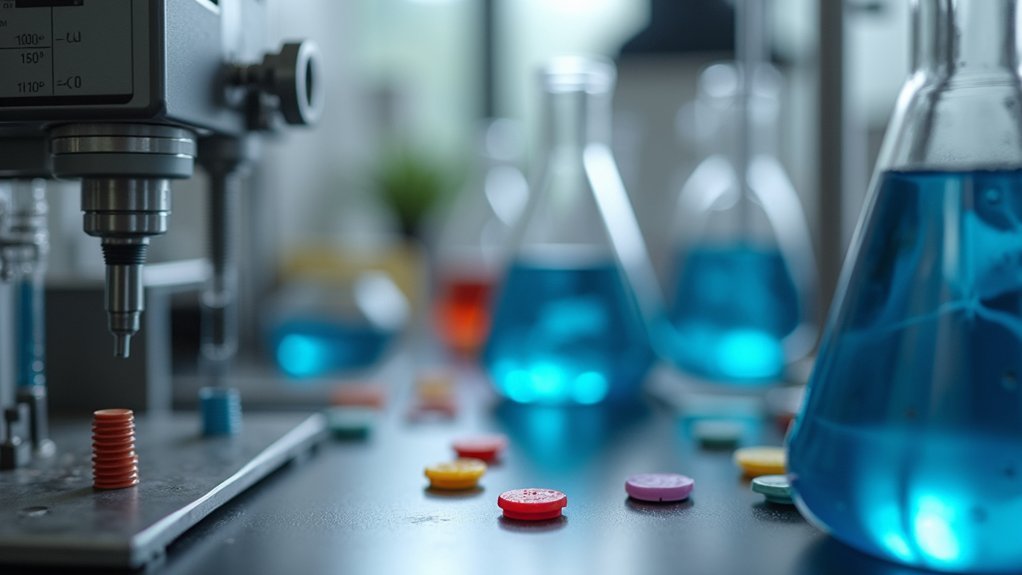



Leave a Reply